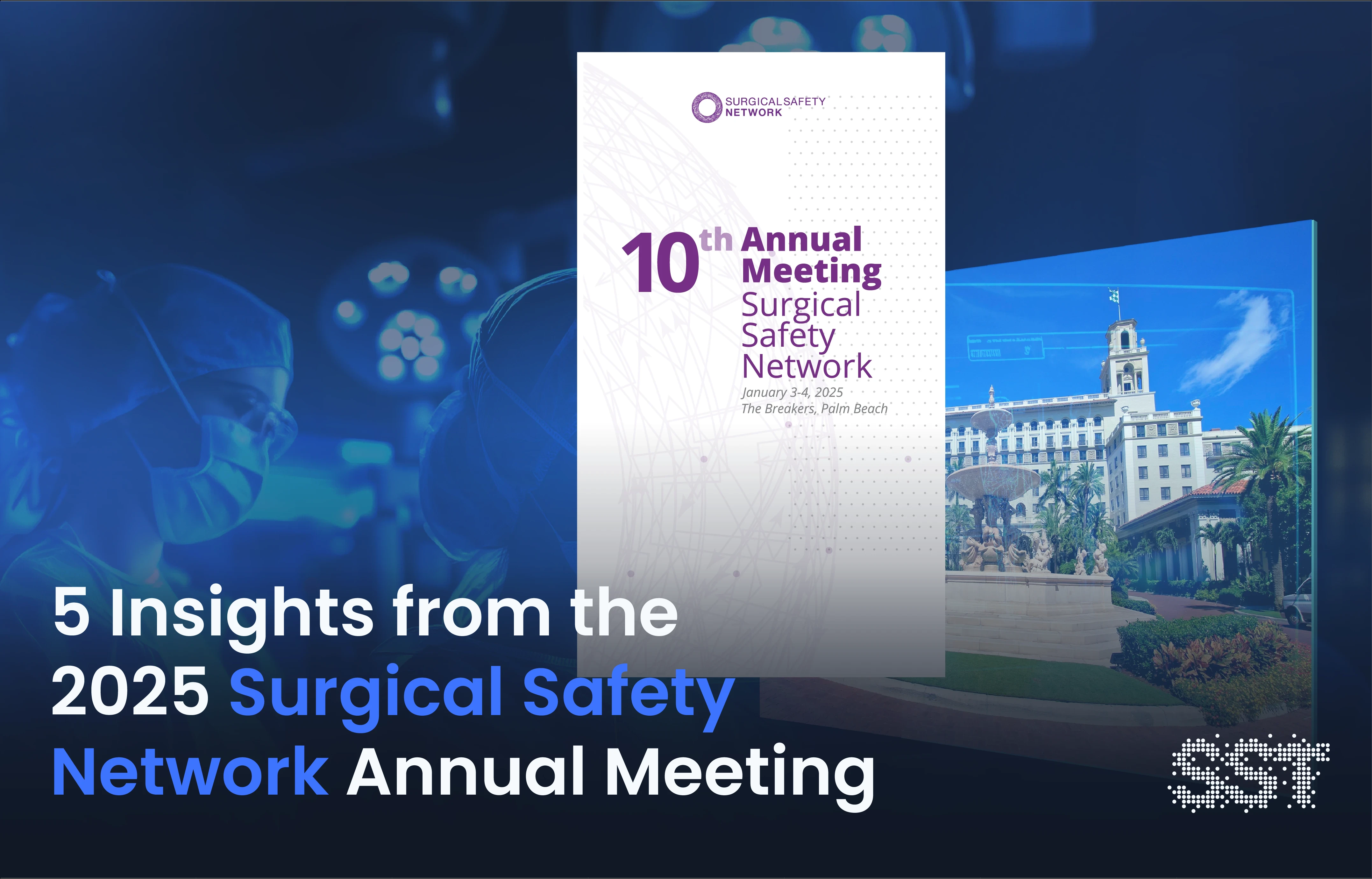PATIENT SAFETY
Spotlight On Safety: 3 Takeaways from the IHI Patient Safety Congress
The IHI 2024 Patient Safety Congress brought together healthcare leaders and professionals with a shared mission: to ensure safe and equitable care for all.
May 31, 2024
Pansy Schulthess, RN, BScN, MEd, MSc
Customer Success Executive, Surgical Safety Technologies
The Institute for Healthcare Improvement (IHI)¹ 2024 Patient Safety Congress, held from May 14 to 16 in Orlando, FL, brought together healthcare leaders and professionals with a shared mission: to ensure safe and equitable care for all. The event was a convergence of insights and strategies from experts in patient safety, quality improvement, risk management, high reliability, population health, patient experience, and more.
This Year’s Focus: National Action Plan to Advance Patient Safety
At the heart of this year’s congress was the National Action Plan to Advance Patient Safety.² This comprehensive guide is designed to help healthcare organizations make significant strides in patient safety and reduce harm across the care continuum. Attendees explored diverse sessions within five educational tracks: Culture, Leadership and Governance; Patient and Family Engagement; Diagnostic Excellence; Learning Systems; and Workforce Safety.
Here are our top three takeaways from the event and their implications for surgical safety:
1. Embodying High Reliability Organization Principles
A major highlight was the emphasis on High Reliability Organization (HRO) principles.³ These five principles—sensitivity to operations, reluctance to simplify, preoccupation with failure, deference to expertise, and commitment to resilience—are crucial for organizations aiming to enhance their safety culture.
Sessions delved into how organizations can start or continue their journey toward high reliability. Discussions covered the importance of parallel planning for implementation and sustainability, integrating HRO principles into existing structures, and using comprehensive assessment and data tools to support ongoing efforts. The consensus? No matter where organizations are on their HRO journey, engaging with these principles is key to fostering a safer healthcare environment.
Surgical safety technologies like the Black Box Platform play a key role in HRO processes. AI-powered surgical video analysis and real-time monitoring systems enhance sensitivity to operations and preoccupation with failure, key HRO principles. Seamlessly integrating these tools into existing workflows, alongside continuous support and education, maximizes their impact on safety culture.
2. The Importance of Safety-II Practices in Safety Culture
Traditional safety approaches, known as Safety-I, focus on minimizing adverse outcomes by understanding and preventing errors. However, the congress highlighted a shift toward Safety-II practices, which view human behavior as a source of creativity and adaptability in managing complex healthcare systems.
One standout session, “Success Cause Analysis as a Strategy to Promote Learning and Staff Engagement,” introduced the concept of “Success Cause Analysis.” This approach uses root cause analysis methods to identify factors that contribute to positive outcomes, promoting system-wide learning and improvement.
Both Safety-I and Safety-II practices were recognized as essential for a comprehensive safety culture, with a growing emphasis on the proactive, resilience-based strategies of Safety-II.
The shift toward Safety-II aligns with the proactive nature of modern surgical safety technologies. AI-driven predictive analytics can identify patterns of success in surgical procedures, supporting the "Success Cause Analysis" approach. This dual approach of preventing errors and replicating successful practices can significantly enhance learning and staff engagement in surgical settings.
3. Preventing Diagnostic Errors
Timely and accurate diagnoses are critical for patient safety and positive health outcomes. Diagnostic errors, which have significant repercussions for patients, families, healthcare professionals, and overall costs, were a key focus of the congress.
A spotlight panel session showcased two new national programs designed to reduce diagnostic errors in the U.S. Highlighted in this discussion was a national study funded by the Agency for Healthcare Research and Quality (AHRQ).⁴ This study invites organizations to implement three innovative diagnostic safety resources: Calibrate Dx,⁵ Measure Dx,⁶ and a comprehensive toolkit⁷ for engaging patients. These tools aim to transform the landscape of diagnostic safety, reducing errors and improving outcomes nationwide.
Expect to hear more about diagnostic safety in the coming months, especially with the upcoming World Health Organization's World Patient Safety Day⁸ on September 17, which will further highlight this crucial aspect of patient safety.
Additional Focus: Clinician Well-being and Retention
Beyond the key takeaways, the congress also shone a light on the importance of clinician well-being and retention. Regular culture of safety surveys, conducted every two years, were recommended to understand, maintain and improve the safety culture within healthcare organizations.
Today’s AI-powered surgical technologies play a crucial role in supporting clinician well-being by reducing stress and cognitive load during surgical procedures. They contribute to a positive safety culture and potentially improve clinician retention. Data from these systems can contribute to the biennial safety culture surveys, providing objective measures of improvement in surgical safety practices.
Attending the IHI Patient Safety Congress reignited our passion for proactive, innovative approaches to patient safety. Surgical Safety Technologies is uniquely poised to help healthcare organizations implement these cutting-edge best practices, building a sustainable and transformative culture of safety that benefits patients and healthcare professionals alike.
Recommended Reading
Institute for Healthcare Improvement. (2020). IHI Home Page. Ihi.org. https://www.ihi.org/
Institute for Healthcare Improvement. (n.d.). National Action Plan to Advance Patient Safety | Institute for Healthcare Improvement. Www.ihi.org. https://www.ihi.org/initiatives/national-steering-committee-patient-safety/national-action-plan-advance-patient-safety
Veazie, S., Peterson, K., & Bourne, D. (2019). Evidence Brief: Implementation of High Reliability Organization Principles. In PubMed. Department of Veterans Affairs (US). https://www.ncbi.nlm.nih.gov/books/NBK542883/
Department of Health and Human Services. (2024). Agency for Healthcare Research & Quality. Ahrq.gov; Agency for Healthcare Research and Quality. https://www.ahrq.gov/
Calibrate Dx: A Resource To Improve Diagnostic Decisions. (2023). Ahrq.gov. https://www.ahrq.gov/diagnostic-safety/tools/calibrate-dx.html
Measure Dx: A Resource To Identify, Analyze, and Learn From Diagnostic Safety Events. (n.d.). Www.ahrq.gov. Retrieved July 16, 2024, from https://www.ahrq.gov/diagnostic-safety/tools/measure-dx.html
Toolkit for Engaging Patients To Improve Diagnostic Safety. (n.d.). Www.ahrq.gov. https://www.ahrq.gov/diagnostic-safety/tools/engaging-patients-improve.html
World Patient Safety Day, 17 September 2024: “Improving diagnosis for patient safety.” (n.d.). Www.who.int. https://www.who.int/news-room/events/detail/2024/09/17/default-calendar/world-patient-safety-day-17-september-2024-improving-diagnosis-for-patient-safety







